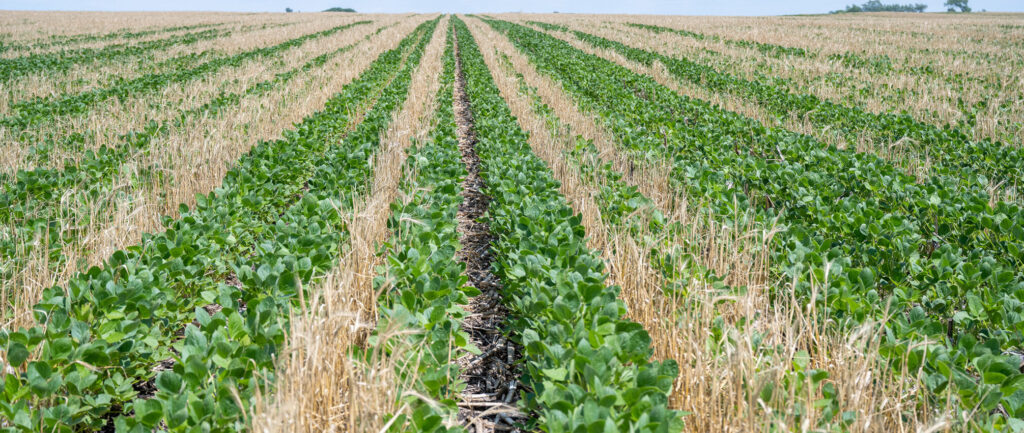The Minnesota Department of Agriculture (MDA) has announced it will follow federal registration and label usage for the herbicide dicamba on dicamba-tolerant soybeans in Minnesota for the 2021 growing season. The cutoff date is set for June 30 or R1 growth stage, whichever comes first.
In October, the U.S. EPA announced it registered XtendiMax with VaporGrip Technology by Bayer (EPA Reg. No. 264-1210), Engenia by BASF (EPA Reg. No. 7969-472), and Tavium Plus VaporGrip Technology by Syngenta (EPA Reg. No. 352-913) with new control measures to curb alleged off-site movement (spray drift and/or volatilization) issues.
From 2018 to 2020, MDA had placed an annual June 20 cutoff date on registered dicamba products based on research and pesticide misuse complaints – a cutoff date that was not included on the federal label – to curb off-site movement; however, the EPA has now limited states’ abilities to impose further application restrictions.
In 2017, the Minnesota Soybean Growers Association created its Drift Task Force, a farmer-led group assembled to examine the data and science behind suspected dicamba damage reports in Minnesota, and find a solution to develop best management practices concerning the use of dicamba in dicamba-tolerant soybeans in the state.
Drift Task Force Chair Bob Worth commended MDA for listening to input from farmer-leaders throughout their decision-making process.
“We appreciate the MDA being transparent and open to having a constructive dialogue with our farmers,” Worth said. “We’re glad to have clarity on this issue. This is a great product, but it can also cause a lot of heartburn between neighbors, and we urge all growers to follow the label to a T.”
New federal label requirements for the products include:
- An application cutoff date of June 30 (unless growth stage cutoff comes first)
- Requiring an approved pH-buffering agent, also known as a volatility reducing agent, be tank mixed with dicamba products prior to all applications.
- Requiring a downwind buffer of 240 feet and 310 feet in areas where listed endangered species are located
- Additional recordkeeping items
In addition to the June 30 cutoff date, Xtendimax and Tavium have crop growth stage cutoffs.
MDA is also requiring product makers provide approved education and training of applicators and provide more Minnesota-specific data on the use of dicamba to inform future department decisions.
“Dicamba is an important tool for combating herbicide-resistant weeds in dicamba-tolerant soybeans,” MDA Commissioner Thom Petersen said. “However, it’s also important to limit impacts on neighboring homes, farms, and gardens. It will be necessary for applicators to understand and follow new label language including complete record-keeping requirements.”
Worth said the Drift Task Force will be urging Minnesota’s approximately 28,000 soybean farmers to heed MDA’s requirements and immediately report any suspected dicamba damage.
“We really want farmers to keep a close on their records this year, because MDA is really going to stress that,” he said. “We’ve been good stewards of this product, and we’re certainly aiming to continue leading on this issue.”
Since dicamba was first registered for use on dicamba-tolerant soybeans in the 2017 growing season, the MDA has fielded complaints each year of alleged off-site movement onto neighboring property. The annual totals of complaints were:
2020: 124 reports
2019: 22 reports
2018: 53 reports
2017: 253 reports
“It is important for famers and applicators to understand that we will increase our enforcement of the use of these products by examining application records. We believe that additional training will help ensure the label is being followed,” Commissioner Petersen said. “We also look forward to working with the University of Minnesota on research to better understand how these products can move off target. Our ability to gather as much data as we can on these products is critical for their continued use in the future.”
In Minnesota, the XtendiMax, Engenia, and Tavium formulations of dicamba are approved for use on dicamba tolerant soybeans only and are “Restricted Use Pesticides” for retail sale to and for use only by certified applicators.
Pesticide product registrations are renewed on an annual basis in Minnesota.
“Farmers right now are choosing their varieties for the upcoming growing season, and having clear direction in this matter will be an asset to Minnesota farmers,” Minnesota Soybean Director of Research David Kee said.




